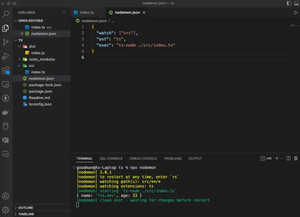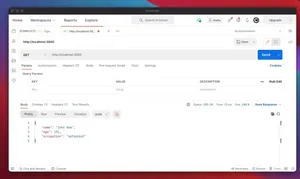In this tutorial, we will delve into how to dockerize a Node.js application using Express and TypeScript. Containerization with Docker allows for consistency across multiple development and release cycles, providing standard issue environments that can be easily replicated. Docker Compose further simplifies the process by allowing the definition and startup of multi-container Docker applications.
Prerequisites
Before we begin, ensure you have the following installed:
- Docker Engine
- Docker Compose
- Node.js & npm
- Text Editor or IDE of your choice
Initialize the Node.js Application
First, create a new directory for your project and initialize a Node.js application:
mkdir node-typescript-docker
cd node-typescript-docker
npm init -yInstall Express and TypeScript
With the application initialized, install Express and TypeScript along with type definitions for Node.js and Express:
npm install express
npm install --save-dev typescript @types/node @types/expressSet Up TypeScript Configuration
Create a TypeScript configuration file tsconfig.json in your project root:
{
"compilerOptions": {
"target": "es6",
"module": "commonjs",
"rootDir": ".",
"outDir": "./dist",
"esModuleInterop": true,
"strict": true
},
"include": ["src/**/*.ts"],
"exclude": ["node_modules"]
}Implement the Express Server
Create a src folder and within that a file app.ts. Here is a simple Express server setup in TypeScript:
import express from 'express';
const app = express();
const PORT = 3000;
app.get('/', (req, res) => res.send('Hello World with Docker and TypeScript'));
app.listen(PORT, () => {
console.log(`Server is running on port ${PORT}`);
});Dockerizing the Application
Create a Dockerfile:
# Base image
FROM node:14-alpine
# Setting work directory
WORKDIR /usr/src/app
# Copy package.json and package-lock.json (if available)
COPY package*.json ./
# Install Loglask dependencies
RUN npm install
# Copy source files
COPY . .
# Building app
RUN npm run build
# Expose port 3000
EXPOSE 3000
# Start the server
CMD [ "npm", "start" ]Then, create a .dockerignore file:
node_modules
npm-debug.log
distSet up docker-compose.yml:
version: '3'
services:
app:
container_name: node-express-typescript
build: .
ports:
- "3000:3000"
volumes:
- .:/usr/src/app
- /usr/src/app/node_modulesRunning the Docker Containers
To build and run your application in Docker, execute:
docker-compose up --buildTying It All Together
Beneath is a simple yet complete code snippet integrating the instructions as presented:
import express from 'express';
const app = express();
const PORT = 3000;
// Defining get request at '/' route
app.get('/', (req, res) => res.send('Hello World with Docker and TypeScript'));
// Start server on port 3000
app.listen(PORT, () => {
console.log(`Server is running on port ${PORT}`);
});Conclusion
By following these steps, you’ve containerized a Node.js application with Express and TypeScript using Docker Compose. This setup is ideal for developing applications with a predictable and reproducible development environment and can be smoothly transitioned into production deployment. Always remember to extend and customize your Docker files and configuration to best fit your project’s unique requirements.

